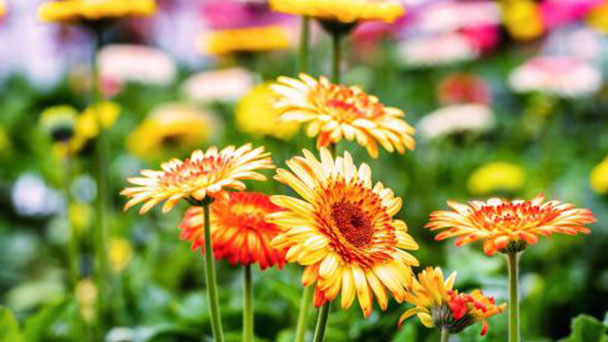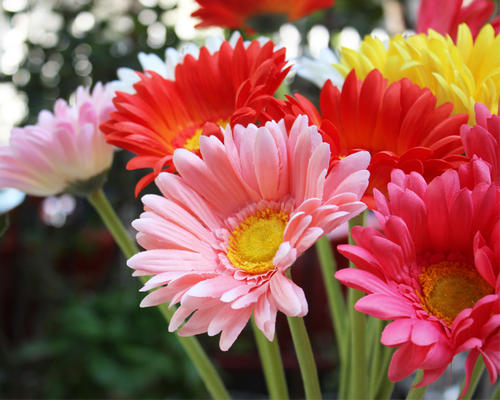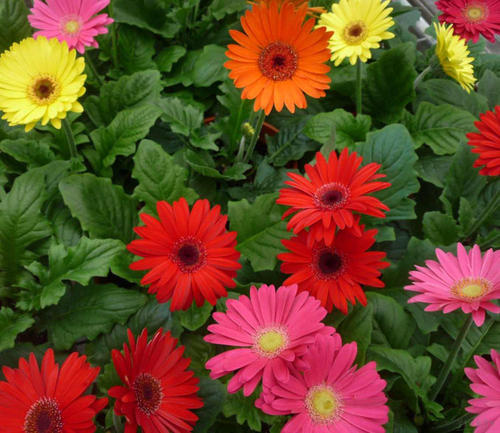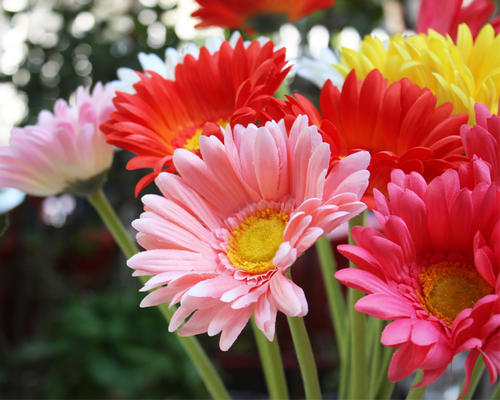Transvaal daisy profile
Written by Maggie
Oct 28 2021

Transvaal Daisy, scientific name Gerbera jamesonii, is a perennial herb in Compositae. Transvaal Daisy is an important material in modern cut flowers. The flower diameter of Transvaal Daisy is large (8cm ~ 10cm), and the flowering period is easy to control. The cultivation area of the cut flowers is increasing year by year, and the application of Transvaal Daisy is becoming more and more widespread. Transvaal Daisy can also be transported long distances and cut flowers can be fed for a long time. Transvaal Daisy is one of the top 10 most beautiful flowers in the world.
Transvaal Daisy Picture
Transvaal Daisy Characteristics
Transvaal Daisy (Gerbera jamesonii) is a perennial, hairy herb. Rhizome is short, surrounded by residual petioles, with thicker fibrous roots.
Leaves of Transvaal Daisy are basal, rosette, elliptic to oblong, 10-14 cm long, 5-6 cm wide, apex mucronate or slightly obtuse, base tapering, margin irregularly pinnately lobed or deeply lobed, glabrous above, pubescent below, depilate when old; Both sides of midvein are raised, thick and especially below, lateral vein 5-7 pairs, curved arch connection from the edge, net vein slightly obvious.
Petiole of Transvaal Daisy is 7 -- 15 cm long, coarsely longitudinally angulate, somewhat hairy. Scape is solitary, or rare several fascicular, 25 -- 60 cm long, bractless, hairy, most densely at apex, capitulate solitary at top of scape, 6-10 cm in diameter when lenticular expanded at flowering; Involucre of transvaal daisy is campanulate, ca. As long as bisexual flowers, up to 2 cm in diam. Involucral bracts 2-tiered, outer linear or subulate, apically acute, 8 -- 10 mm long, 1 -- 1.5 mm wide, abaxially pilose, inner oblong-lanceolate, apically caudate.10-14 mm long, ca. 2 mm wide, margin dry membranous, ridge sparsely pubescent.
Transvaal Daisy Habits
Transvaal Daisy (Gerbera jamesonii) likes warm in winter and cool in summer, with air circulation and sufficient sunshine. Transvaal Daisy (Gerbera jamesonii) is not cold resistant and avoids heat. The suitable temperature for growth is 20℃ ~ 25℃, and the suitable temperature in winter is 12℃ ~ 15℃. When the temperature is lower than 10℃, the growth stops. Transvaal Daisy belongs to semi-cold-resistant flowers and can tolerate the short-term low temperature of 0℃. In South China, it can be used for open-ground perennial root flower cultivation; the East China area must cover overwintering or in the greenhouse to cut flowers to facilitate cultivation. Transvaal Daisy likes fertile loose, well drained, rich in humus sandy loam, avoid sticky heavy soil, suitable for slightly acidic soil, in the neutral and slightly acidic soil can also grow, but in alkaline soil, leaves are easy to produce lack of symptoms.
Flowering control of Transvaal Daisy (Gerbera jamesonii) is very easy. As long as the room temperature is kept above 12℃, the plants can not enter dormancy and continue to grow and blossom. Transvaal Daisy likes fertile loose, well drained, rich in humus sandy loam, avoids viscous heavy soil, should be slightly acidic soil, belongs to the semi-cold-resistant flowers, and can tolerate the short-term low temperature of 0℃. As a light-loving plant, Transvaal Daisy should be cultivated in a place with sufficient light. Seedling should not be planted too deep, the roots and shoots should be exposed to the soil. If light is poor, the pedicels are soft and drooping, and the cut flowers are not of high quality.
Transvaal Daisy Origin
Transvaal Daisy originates (Gerbera jamesonii) from Transyaal, South Africa.
Transvaal Daisy Value
Transvaal Daisy (Gerbera jamesonii) life is long, up to 7~10 days, suitable for cut flowers, potted flowers, flower beds; Garden open cultivation, balcony flower groove.

Transvaal Daisy Care
Transvaal Daisy Temperature Care
The optimum growth temperature for Transvaal Daisy (Gerbera jamesonii) is 20-25℃, lower than 5℃ and higher than 30℃, with slow growth. Transvaal Daisy is quite sensitive to temperature difference, and it is better to keep the temperature difference between day and night at 2-3℃. If the temperature difference is too large, deformed flowers will be caused. Shading is recommended during strong light to avoid excessive temperatures, and spraying water during midday heat.
Transvaal Daisy Light Care
Transvaal Daisy (Gerbera jamesonii) likes a sunny environment. The plants grow healthily and the flowers and colors are bright. No less than 12 hours of sunshine per day, 3.5-4Klx artificial light supplement in low light period.Illumination time and intensity directly affect the yield of Transvaal Daisy (Gerbera jamesonii). The longer the illumination time, the higher the flower yield.
Transvaal Daisy Watering
Transvaal Daisy blooms (Gerbera jamesonii) all the year round in facility cultivation and consumes a lot of nutrients, so continuous topdressing is required throughout the growth period. Drip irrigation equipment should be used to prepare nutrient solution for drip irrigation. Nitrogen fertilizer for Transvaal Daisy was the main fertilizer, phosphorus, potassium fertilizer and calcium, iron, magnesium fertilizer should be added appropriately, and special attention should be paid to potassium fertilizer supplement before flowering to promote the stem thick and strong flowers and increase flower yield. The relative humidity of air had better not exceed 70%. In order to make the Transvaal Daisy roots grow well, irrigation should be carried out after pouring the planting water until the roots are slightly dry, and top dressing should be applied at the same time. Watering to "dry thoroughly watering" as the principle. Flowering irrigation should be careful not to make the center of the leaf cluster water, to prevent the rot of flower buds.
Transvaal Daisy Pruning
Transvaal Daisy (Gerbera jamesonii) is an annual production, so the leaves and buds should be pruned in time. Too much or too little leaves will reduce the number of Transvaal Daisy flowers, so it is necessary to properly peel the leaves, remove the yellow leaves at the lower part of the basal leaf cluster in time, and then evenly peel the leaves of each branch, leaving 3-4 functional leaves on each branch.In the early stage of seedling growth, the early buds should be removed to promote vegetative growth. Flowing period, excessive Transvaal Daisy buds should also be sparse, in order to ensure the crystal quality of cut flowers. At the same time, market and seasonal factors should be considered to determine the number of flower branches.
Transvaal Daisy Propagation
Division Propagation
It is suitable for some Transvaal Daisy (Gerbera jamesonii) varieties with strong tillering ability. Planting was mostly carried out in spring. New ramets must have buds and roots, so should not be divided too small. When dividing, first cut the plant into several plants longitudinally with sharp tools along each ramet, and then dig up and transplant the separated ramets after the wound is healed.
Cutting Propagation
It's best to do it in spring. Enhanced management of cuttings can be flowering in the second half of the year. Transvaal Daisy won't flower until the following spring. The mother plant should be used to grow more than 1 years of plants, dig up the robust plants, wash the root mud, remove leaves, cut off the growth point, carefully retain the thick part of the rhizome, and then plant in the planting box. When the temperature is 22-34℃, air humidity is 70%-80%, after 10-14 days, that is, desirable cuttings. In order to accelerate the cutting root, Transvaal Daisy can first be cut into 0. 2% potassium permanganate solution dipped in the wet (disinfection and disease prevention), and then the base inserted into the market of root powder or 500 mg/l of naphthalene acetic acid solution, and then cutting.
Sow Propagation
Small seeds of Transvaal Daisy (Gerbera jamesonii) were planted indoors, and the suitable temperature for germination was 18-22℃. Germination was carried out 7-10 days after sowing. After germination, they should be moved to the sunny place, and seedlings should be divided after the cotyledon is fully developed. When seedlings grow 2 true leaves, they can be colonized.

Read Next:
Top 10 Most Beautiful Roses in the World
Top 10 Most Beautiful Flowers in the World
26 Best Autumn Flowers to Plant for Fall Color in Garden
Latest Updated
- Benefits of Bugleweed - 7 Science-backed Health Benefits
- Bugleweed Dangers & Side Effects - Is It Poisonous?
- How to Plant Evergreen Trees - What You Should Know
- When to Plant Evergreens - Grow Guide for Evergreen Trees
- 12 Wonderful Evergreen Shrubs for Your Garden
- 12 Popular Evergreen Plants with Pictures for Beginners
- When And How To Prune A Lilac Bush Like a Pro
- How to Grow & Care for Lilac Vine (Hardenbergia Violacea)
- Japanese Lilac Tree (Syringa Reticulata) Care & Propagation Guide
- Shumard Oak Pros and Cons - What to Know
Popular Articles
- Winter maintenance of Antirrhinum Majus
- How to Grow Terminalia Mantaly Tree
- How to Grow and Care for Crossostephium Chinense
- How to grow Antirrhinum Majus in spring
- Peristeria Elata (Dove Orchid) Profile: Info & Care Guide
- Underwatered Snake Plant (Sansevieria Trifasciata) - Signs And How To Fix
- How to Care for Brazilian Jasmine Plant (Mandevilla Sanderi)
- How to Grow & Care for Graptopetalum Purple Delight in Summer
- Rosa Chinensis (China Rose): Plant Growing & Care Tips
- How to Care for Baby Sun Rose (Aptenia Cordifolia)
